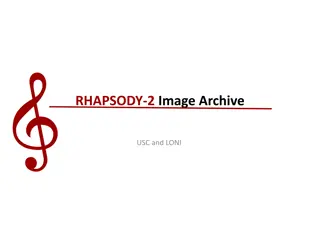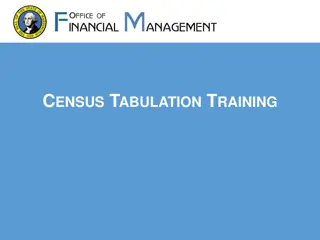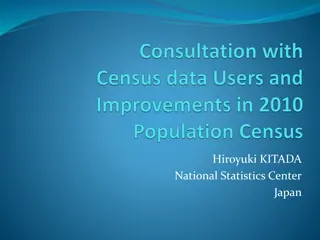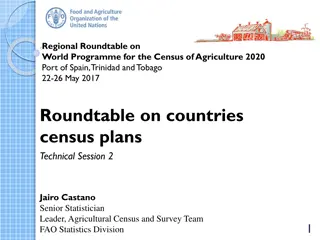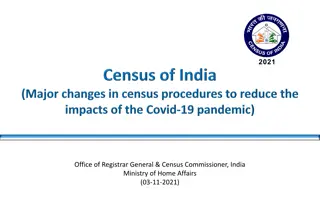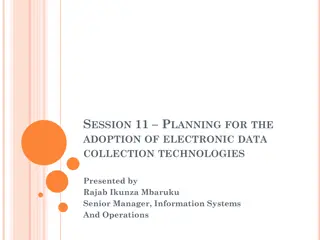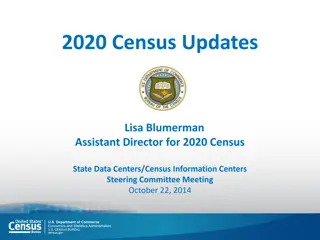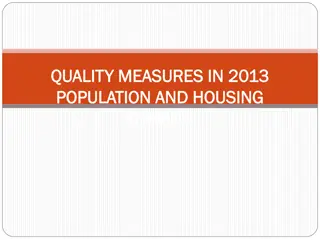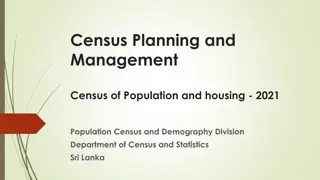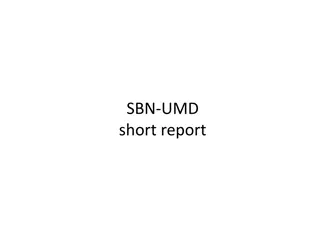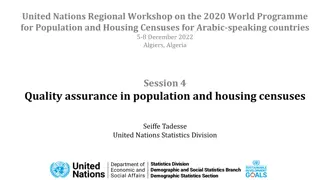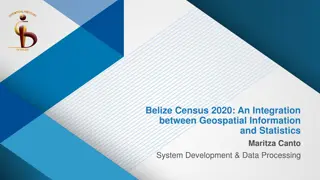
Key Aspects of Agricultural Census Tabulation and Dissemination
Explore the crucial elements of tabulation, archiving, and dissemination in agricultural census programs, emphasizing the preparation of statistical tables, data coherence, and comparability with past censuses. Learn about standard statistical tables, classification variables, and the significance of ensuring accurate information for effective decision-making in agriculture.
Download Presentation

Please find below an Image/Link to download the presentation.
The content on the website is provided AS IS for your information and personal use only. It may not be sold, licensed, or shared on other websites without obtaining consent from the author. If you encounter any issues during the download, it is possible that the publisher has removed the file from their server.
You are allowed to download the files provided on this website for personal or commercial use, subject to the condition that they are used lawfully. All files are the property of their respective owners.
The content on the website is provided AS IS for your information and personal use only. It may not be sold, licensed, or shared on other websites without obtaining consent from the author.
E N D
Presentation Transcript
Regional Roundtable World Programme for the Census of Agriculture 2020 Bangkok, Thailand 19-23 September 2016 Census Tabulation, Archiving and Dissemination Technical Session 18 Oleg Cara Agricultural Census and Survey Team FAO Statistics Division 1
Contents Tabulation Dissemination of aggregate results Safe access to census microdata Archiving Country examples 2
Tabulation programme A set of statistical tables prepared to present the main census results, based on the users primary needs It is paramount for developing the census questionnaire and to ensure that all relevant census information is included Countries should produce basic standard tables using a wide range of methods of dissemination and media to ensure the widest dissemination of the census results 3
Tabulation programme (contd.) Coherence and comparability: with previous censuses (when available) other statistical data relevant and reliable administrative data sources (land cadaster information, agricultural machinery, organic farming, etc.) international comparability (including the use of recommended classifications/ tabulation classes) Tabulation plan with main tables must be developed before designing the census questionnaires 4
Standard statistical tables Totals for items collected, such as: total area of holdings according to land use (or land tenure) types or number of animals for each livestock type. Total number of units with certain characteristics, such as the number of holdings with both agricultural land and livestock or only with land, or just animals. Averages for items, such as the average area of the holding or number of parcels per holding. Percentages (e.g. of holdings using organic fertilizers or with animals). 5
Classification variables Classification variables are characteristics used for data tabulation. Nine main classification variableshave been identified for tabulations of the essential items: 1. Administrative unit or agro- ecological zone 2. Legal status of agricultural holder (type of holder) 3. Total area of holding 4. Area of agricultural land (as well as by main land use classes, e.g. arable land, land under permanent crops) 5. Number of livestock (for a particular livestock type) 6. Main purpose of production of the holding 7. Household size by sex and age group 8. Sex of agricultural holder 9. Age of agricultural holder. 6
Tabulation classes Often, classification variables need to be formed into suitable classes for presentation in the tables. FAO recommends to use census essential items for the tabulation classes. Examples: Essential item/classification variable Tabulation classes Legal status of agricultural holder (type of holder) A civil person Group of civil persons Juridical person Age of agricultural holder Holder is a civil person Under 25 years 25 34 years 35 44 years 45 54 years 55 64 years 65 years and over Joint holders 7
Tabulation classes (contd.) Consistency between statistical collections in the country (e.g. using the same age groups (for ex. 25-34, 35-44, etc.). International standards: countries should adhere to those wherever possible to help in making comparisons between countries. To meet national reporting needs, more disaggregated classes are encouraged (to allow for re-aggregation). Where countries wish to use different class groupings in their standard reports, they should also report the results according to the guidelines given in the WCA 2020 for international comparison purposes. For more details see WCA 2020, Table 10.1: Agricultural census essential items: tabulation classes. 8
Territorial profile of census results Different levels, by: administrative regions/rayons agro-ecological zones communities other small areas Dissemination of data items which are relevant, meaningful for a particular level and ensure data confidentiality 9
Territorial profile of census results (contd.) The level of administrative units to be presented in the tables could be a decisive factor in designing: census methodologies (choosing between complete or sample enumeration, defining agricultural holding within the border of a region) census tools e.g. questionnaires with special sections or annexes completed for each administrative unit where land and/or livestock is located (e.g. Armenia, Italy, Romania, etc.). 10
Cross-tabulations Census data classified by two different items simultaneously, e.g.: the number of holdings classified by area of holding and livestock (by each area/livestock number class) the number of holdings classified by age of holder and area of holding (by each age/area class) Are useful for in-depth studies For more details see WCA 2020, Table 10.2: Agricultural census essential items: recommended cross-tabulations. 11
Tabulations: census scope and coverage Agricultural holdings: establishments engaged in agricultural production activities Aquaculture activities of agricultural holdings Capture fisheries activities conducted at household level Widened production households) census (including both agricultural and non-agricultural Community-level data Tabulationswith more details on some sub-populations of holdings (such as large or special holdings ). 12
Tabulations: community-level data Community-level data in an agricultural census can be tabulated in two ways: To summarize the characteristics of communities To use as classification variables for tabulations against holding- level data, such as: number and area of holdings number of households and population. 13
Tabulations: community-level data (contd.) Typical community-level classification variables are: Access to urban centre Risk of natural disasters Economic status Occurrence of seasonal food shortages Presence of a periodic or permanent agricultural produce market Access to veterinary services Access to farm input trading centre Access to credit institutions Access to farmers association Presence of specific development projects. 14
Aquaculture tabulations: classification variables Administrative unit or agro-ecological zone Legal status of holder Area of holding Area of aquaculture Household size Sex of holder Age of holder 15
Dissemination - key stage of a census Dissemination is one of key stages of the census process where the census data are made available to users and long- term preservation is ensured Main purpose of the census - meeting users needs for data through provision of structural data on agriculture Ensure access to a wide range of relevant data International comparability (including the use of classifications/ tabulation classes) Explanation of inconsistencies between census results and other data sources Contribute to users/ stakeholders extended use and trust in census results. 16
Dissemination - key stage of a census (contd.) Institution s dissemination Policy Dissemination plan Large consultations with main stakeholders Timely results Supply a variety of products Technologies/Dissemination Media Quality Assurance (relevance, accuracy and relibility, coherence and comparability (including international comparability), timeliness and punctuality, accessibility and clarity, confidentiality, etc.) Census Metadata 17
Metadata Metadata( data about data ) provide information about one or more aspects of the data Should include quality measures Metadata help users: understand what the data are measuring and how they have been created, prevent them from misunderstanding the data and helps to promote appropriate use of the data understand the quality of data by providing information about thedata collection process better interpret and use the census results. 18
Dissemination products Standard census tables and reports with census results for general distribution: o Summary report of key results o Final report on the main results o Brochure presenting the key results o Thematic reports o Detailed data tables (in electronic formats) Maps Graphs and charts Technical report containing metadata and methodological and operative actions along with census questionnaires and other census forms 19
Methods of dissemination and media Printed publications CD-ROMs Pen drives Internet o Access to the public database so that users can generate their own specific set of tables o Use of web-based mapping and GIS Safe access to census microdata. 20
Microdata Microdata are the data recorded on the unit of enumeration, they allow users to carry out a wider range of analysis than with aggregate data. Each set of information about a unit represents a microdata record. Access to Census microdata: o Allows users to carry out a wider range of analyses than is possible with aggregate data o Legal framework o Organizational and technical framework o Confidentiality of the information recorded from respondents must be strictly preserved. 21
Methods for access to microdata 1. Public Use Files (PUFs): these files undergo a rigorous statistical disclosure control (SDC) process so that the chance of re- identification of respondents is minimal. 2. Licensed Files: licensed files are also anonymised but with the possibility of fewer SDC procedures being applied. Researchers are asked by NSO to be explicit about the research that they are doing and to sign a license on the conditions of microdata s use. 22
Access to microdata (contd.) Remote Access Facilities (RAFs): with a service window provided by NSOs which allow researchers to supply the algorithm and tools they will be using. NSO s staff can run the job against the actual data set before returning the output to the user. Data enclaves: a facility within the premises of the NSOs to which researchers can come in order to perform their research on detailed files. Deemed Employee: a researcher may be sworn in to work with the agency as a temporary staff member. In this case the researcher would be subject to the same secrecy and ethical provisions and as the regular staff. 3. 4. 5. For more details see Providing Access to Agricultural Microdata: A Guide (Global Strategy, 2014). 23
Data archiving A means of ensuring long term preservation of data. Assists users in understanding and interpreting the data. Ensures the continued access to the census data by users over long periods of time. Primarily relates to digital data. Digital data can be vulnerable to obsolescence of enabling technologies, from hardware and software used to store and access the data to physical damage and to loss due to the passage of time. 24
Data archiving (contd.) Should include: raw microdata edited microdata, macrodata the appropriate metadata census dissemination products census tools such as computational programs, conversion tables, enumeration manuals, training manuals, supervision manuals, questionnaires, cartography, etc. 25
Data archiving (contd.) Safe storage of the data in a sustainable environment: with appropriate policies and procedures ensuring that the archived census data can be made available over time to authorised users. More detail in International Household Survey Network. Working Paper 3: Principles and Good Practices for Preserving Data (IHSN 2009). 26
Public events to disseminate the main census results Important national events performed in accordance with Dissemination Strategy and Plan, such as: o National seminars to disseminate the main census results along with regional dissemination seminars o Press conferences. The events organized to present: o Preliminary census results o Final census results. 27
Country examples Niger, General Census of Agriculture and Livestock 2004-2008: Results are available from: printed reports and brochures, CD-ROM s, the website of CountrySTAT-Niger (http://countrystat.org/home.aspx?c=NER&tr=55) the website of the National Institute of Statistics (http://www.stat- niger.org/NigerInfo/rgac/indexe.html) upon request. 28
Country examples (contd.) Canada, 2011 Census of Agriculture: There are three major releases (online and free of charge): Basic counts and totals for all farm and farm operator variables tabulated at the national, provincial and three sub-provincial areas. All these data are also available in a dynamic format for self-serve user- defined tables. These data were also later made available in Statistics Canada online main database (CANSIM). Selected historical farm and farm operator data (some series covering 1921-2011). Available in CANSIM. Selected data on social characteristics of farm operators, census farm families and the farm population, based on the agriculture-population linkage database. Data are available in CANSIM. 29
Country examples (contd.) Canada, 2011 Census of Agriculture: Publications on: The 2011 Census agricultural regions boundary file and reference guide and reference maps The Agricultural ecumene boundary file and reference guide Canadian Agriculture at a Glance Maps, full-colour photos, graphs and charts give its diverse array of subjects an eye-catching and informative visual interpretation to complement the articles. All publications are available from Statistics Canada s website free of charge. 30
THANK YOU 31

